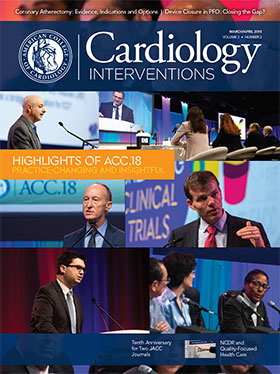Quality Improvement | NCDR's Role in a Quality Focused Health Care Landscape


As the health care system shifts its focus toward value-based care, quality improvement initiatives have made their mark. And the key to developing a successful quality improvement program lies in the availability of clinical data. With data on patient care and outcomes, institutions can measure performance, identify areas for improvement and benchmark against other facilities. For patients with cardiovascular disease, national registries like NCDR offer the best way to collect that data and measure outcomes and quality, according to Frederick A. Masoudi, MD, MSPH, FACC, chief science officer and chair of the NCDR Management Board.
In a 2017 article in the Journal of the American College of Cardiology, Masoudi, et al., wrote that NCDR data “provide a unique, clinically rich national perspective on the care and outcomes of high-impact cardiovascular conditions and procedures that are not available elsewhere.” Masoudi recently spoke with Cardiology: Interventions about NCDR’s future in a value-based health care system and how NCDR data are helping cardiovascular care teams across the country improve care and outcomes.
What is the role of NCDR in the changing health care landscape?
NCDR is increasingly important. Although the path to a value-based system is still somewhat murky, there is no doubt that our payment system is evolving to one in which reimbursement is based more on quality rather than on the quantity of care we deliver. In a fee-for-service environment, you only need to think about how many procedures you do or the number of patients you see. But in a quality-based system, you need to think about delivering the right care for the right patient at the right time. In order to do this, we need to be able to measure the quality of care we deliver. The best way to do that for patients with cardiovascular disease is to participate in a national registry program like NCDR. Our registries use standardized clinical data to characterize quality and outcomes against national benchmarks, which provide targets for improvement activities for our participants.
There is a growing understanding that delivering high-quality care is part of our professional responsibility. NCDR’s formula has been successful in supporting a quality improvement community that is becoming increasingly large as physicians, hospitals and the entire cardiovascular care team have recognized the importance of measuring quality. We can’t just deliver the care we think is best and move on without really measuring or understanding what we’re doing. We have to spend time making sure that we take full advantage of all the data we have.
How is NCDR advancing health care innovation?
We’ve been developing robust risk-assessment tools that allow practitioners to provide personalized care that is tailored to the patient with respect to the benefits and risks related to particular therapies. We’re working on turning those models into meaningful tools to help clinicians personalize the care they deliver. We also continue to conduct cutting-edge research on health services that will help inform the national quality landscape and guide policymakers to do things that are in the best interest of patients. Finally, we are exploring partnerships to enhance our capacity to guide institutions to implement best practices.
How is NCDR working with other members of the cardiovascular care team to improve quality?
NCDR and ACC Accreditation Services are working closely to align our activities and ensure engaging all important constituencies in the cardiovascular care team. That includes emergency medical services (EMS) staff, nurses and other team members who interact with patients. This is not a physician-centric operation. It’s a team-centric operation. Working with EMS is particularly important with the Patient Navigator Program: Focus MI and the ACTION Registry. Certain data elements pertain to the EMS interaction with patients. We put a strong emphasis on the need for teamwork throughout the chain of care.
NCDR celebrated its 20th anniversary in 2017. What are some of its major accomplishments?
NCDR has expanded substantially in terms of the number of programs and the number of physicians, care team members and health systems that participate. We now have 10 registries that span the cardiovascular space, including the outpatient area with the PINNACLE Registry — which is celebrating its 10th anniversary this year — and the Diabetes Collaborative Registry. The CathPCI Registry, our first registry, is woven into the fabric of care for cath labs across the country and is used in nearly all U.S. hospitals that perform PCI.
Our registries have supported post-market surveillance studies and satisfied coverage determinations issued by the Centers for Medicare and Medicaid Services. At the end of the day, NCDR data has touched the lives of more than 80 million patients. That is quite a story. We’ve published nearly 400 peer-review papers that have helped advance knowledge of cardiovascular disease. We have been able to generate knowledge about cardiovascular care and outcomes on a national scale that would not be possible without NCDR and its registry participants. And we are using that data to advocate for patients.
In addition, NCDR has supported national quality initiatives like ACC’s Door to Balloon (D2B) initiative, which was associated with a marked, sustained improvement in delivering timely PCI to STEMI patients. Before the D2B project, about 70 percent of patients had timely PCI, despite the existence of guidelines and a focus on getting patients primary PCI within 90 minutes. At my hospital and many others, failing to get patients to PCI within 90 minutes almost never happens now. More recently, we’re leveraging the ACTION Registry as part of ACC’s Patient Navigator Program, which aims to reduce readmissions and improve outcomes for patients who suffer a myocardial infarction.
What will NCDR be working on in the coming years?
One of our big concerns is minimizing the burden of data collection. We’re going to further integrate our data collection, recognizing that a key factor that distinguishes NCDR is the availability of very detailed clinical data that speak to the patient population. There is clearly a need for standardized clinical data, but we want to do everything possible to ensure that we limit the burden. We are exploring mechanisms to engage patients directly and collect data on patient-reported outcomes like health status.
One of the issues we’ve struggled with more recently is federal reimbursement policies. There is still a lot of uncertainty about what a value-based payment approach will look like. With a moving environment in terms of what constitutes qualification for federal plans, the lack of certainty creates important challenges. Rather than reacting to specific policies, we aim to provide value to our participants as they make the transition to payment for quality.
Keywords: ACC Publications, Cardiology Interventions, Accreditation, Atrial Fibrillation, Benchmarking, Cardiovascular Diseases, Centers for Medicare and Medicaid Services, U.S., Diabetes Mellitus, Electronic Health Records, Electrophysiology, Emergency Medical Services, Fee-for-Service Plans, Medicaid, Medicare, Myocardial Infarction, Outpatients, Patient Care, Patient Navigation, Patient Readmission, Peer Review, Percutaneous Coronary Intervention, Quality Improvement, Quality of Life, Referral and Consultation, Registries, Risk Assessment, Uncertainty
< Back to Listings




